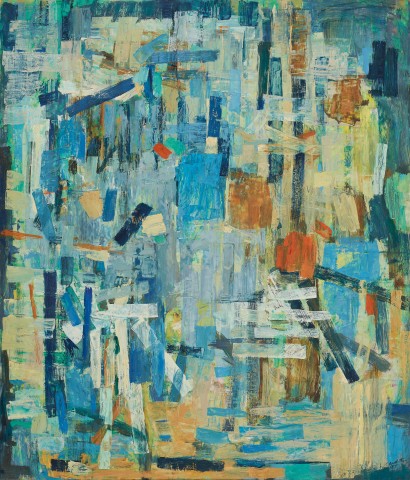CANTATA NO. 17, 1968 – 69
YVONNE AUDETTE
oil on composition board
102.0 x 86.0 cm
signed and dated Iower right: Audette/69
signed, dated, and inscribed with title verso: Audette / 1968-69 / Cantata No. 17 /… Audette
Metro 5 Gallery, Melbourne
Private collection, Sydney, acquired from the above May 2001
Audette’s Audettes: Works from the Private Collection of Yvonne Audette, Metro 5 Gallery, Melbourne, 8 – 27 May 2001, cat. 3 (illus. in exhibition catalogue)
Heathcote, C., and Adams, B., Yvonne Audette Paintings and Drawings 1949 – 2003, Macmillan, Melbourne, 2003, pl. 125, p.194 – 195 (illus.)
Well-heeled, well-travelled, and well-connected with influential members of the New York Avant Garde, Yvonne Audette cut an unusual figure in the Sydney art scene of the late 1960s. Returning to her hometown of Sydney in 1966 after many years living in New York and Italy, Audette had matured as a painter, working now in a subtle and nuanced abstract style derived from the ambiguous mark-making of European Art Informel. She would spend three years in Sydney before moving permanently to Victoria. During this time Audette established her overseas credentials and began to carve a spot for herself amongst her largely male peers.
While some of Audette’s works of the early 1960s incorporated calligraphic markings influenced by the sgraffito technique of Cy Twombly, who also lived as an expat in Italy, Cantata #17, 1968-69 stays resolutely geometric. Governed by a densely woven lattice of cumulative blocky brushstrokes and shapes, its vertical composition is reinforced by dense and layered vertical lines. The arrangement of iterated strokes, hatchings, and scumbled squares jostle against each other with sometimes startling colour contrasts, layered upon one another in noisy and dense palimpsests. In 1968, James Gleeson wrote ’perhaps the closest analogy with her [Audette’s] art is the palimpsest, for both are an accretion of written shapes on a surface stirring with earlier writings vanquished by time or by deliberate, though imperfect, erasure. These phantoms flicker palely among the living signs and there are many degrees of fading.’1 Indeed, Audette’s paintings are often more than the sum of their parts, not clean edged and decisive, but ambiguous and edging closer to a resolution that is built up over time in small accretions and subtractions. The artist is well-known for holding the majority of her works in her studio for review and revision over many years, and while this work was completed in a relatively short span of one year, it was not exhibited until 2005, in an exhibition of works from the artist’s own personal collection.2
These lyrical abstract compositions reflected the multilayered histories Audette encountered in Europe: ‘When I went to Europe in the mid-50s … my work responded to the layering of society itself – the remnants of murals on walls, the frescoes, the whole antiquity of the civilisation.’3 Some marks are sharp and clear, in the uppermost stratum of paint, while others are wiped clean away before being further obscured by super-imposed shapes and competing hues. In this swarming surface, one can discern the bright tones of Sydney harbour, particularly in comparison to Audette’s dark Italian works. Cantata #17 plays on the idea of musical harmony and invention, as hinted by the title of this series. Drawing inspiration from the ’mystical joy’ the artist found in the polyphonic genius of J.S. Bach’s compositions, this series explores variations on a theme, weaving together independent melodies and harmonies of colour.4
The history of art in Australia is indebted to Audette’s choice to return. For all of her thrilling globe-trotting, the pull of the Australian landscape was too strong to ignore. She returned to these shores convinced that the country’s comparative isolation presented a strong opportunity for Australian artists to forge their own path in abstract art, one that was an expression of national identity rather than one opposed to it. Within this milieu, Audette holds a unique place as one of the few female artists of her generation to have maintained a long and successful career working in an abstract mode.
1. Gleeson, J., ‘Elating Shaking Yvonne’, Sydney Sun Herald, 25 February 1968
2. Audette’s Audettes, Metro 5, Melbourne, 2001
3. The artist quoted in McCulloch-Uehlin, S., ‘Abstraction’s Forgotten Generation’, The Australian, 23 April 1999, p.9
4. The artist’s notes, 1999, cited in Heathcote, C., et. al., Yvonne Audette: Paintings and Drawings 1949-2003, Macmillan, Melbourne, 2003, p. 170
LUCIE REEVES-SMITH
